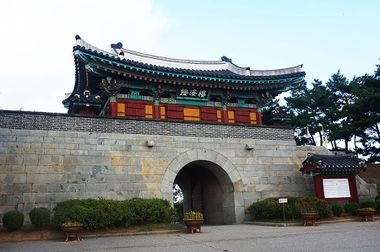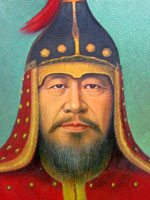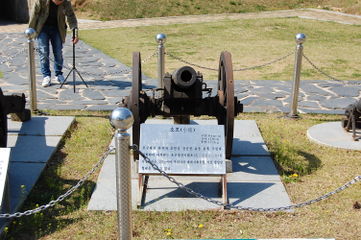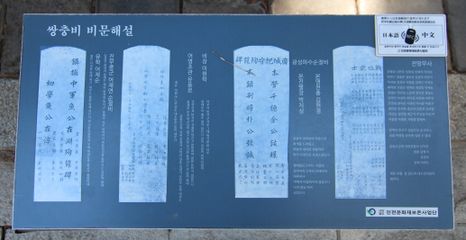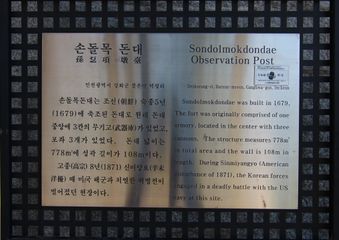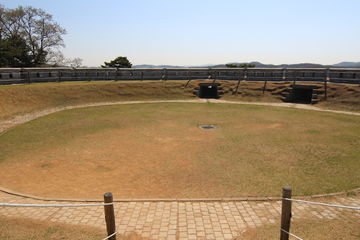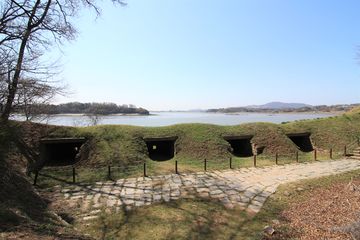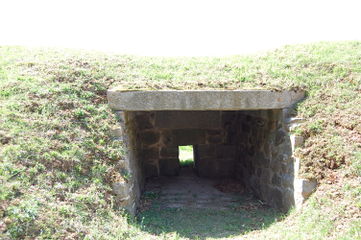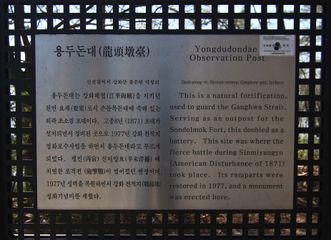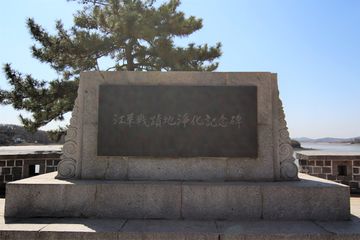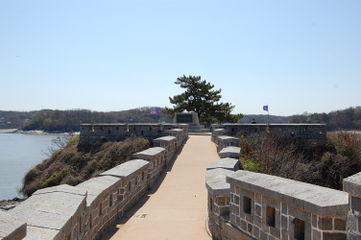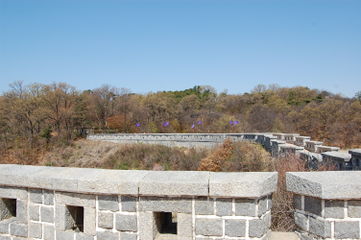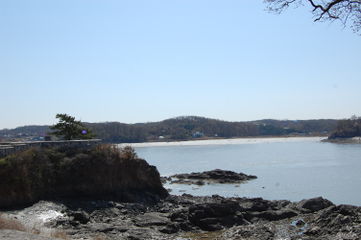"광성보"의 두 판 사이의 차이
(→지도) |
(→용두돈대 / Youngdudondae Observation post) |
||
| (3명의 사용자에 의한 81개의 중간 편집이 숨겨짐) | |||
| 20번째 줄: | 20번째 줄: | ||
=='''개관'''== | =='''개관'''== | ||
| − | + | ==='''한국어'''=== | |
| − | === | + | 광성보는 [https://terms.naver.com/entry.nhn?docId=1169514&cid=40942&categoryId=33537 덕진진], [https://terms.naver.com/entry.nhn?docId=1147128&cid=40942&categoryId=33537 초지진], [https://terms.naver.com/entry.nhn?docId=554702&cid=46656&categoryId=46656 문수산성] 등과 더불어 [https://terms.naver.com/entry.nhn?docId=1247807&cid=40942&categoryId=33365 강화해협]을 지키는 중요한 요새이다. 고려가 몽고 침략에 대항하기 위하여 강화로 도읍을 옮기면서 1233년부터 1270년까지 [https://terms.naver.com/entry.nhn?docId=5144369&cid=46656&categoryId=46656 강화외성]을 쌓았는데, 이 성은 흙과 돌을 섞어서 쌓은 성으로 바다길을 따라 길게 만들어졌다. [https://terms.naver.com/entry.nhn?docId=1065208&cid=40942&categoryId=33383 광해군] 때 다시 고쳐 쌓은 후 [https://terms.naver.com/entry.nhn?docId=1156058&cid=40942&categoryId=33383 효종] 9년(1658)에 광성보가 처음으로 설치되었다. [https://terms.naver.com/entry.nhn?docId=3574309&cid=59015&categoryId=59015 숙종] 때 일부를 돌로 고쳐서 쌓았으며, [https://terms.naver.com/entry.nhn?docId=1248128&cid=40942&categoryId=35446 용두돈대], 오두돈대, [https://terms.naver.com/entry.nhn?docId=1192864&cid=40942&categoryId=33383 화도돈대], [https://terms.naver.com/entry.nhn?docId=1248111&cid=40942&categoryId=33537 광성돈대] 등 소속 [https://terms.naver.com/entry.nhn?docId=1083670&cid=40942&categoryId=32340 돈대]가 만들어 졌다. [https://terms.naver.com/entry.nhn?docId=567682&cid=46622&categoryId=46622 영조] 21년(1745)에 성을 고쳐 쌓으면서 성문을 만들었는데 ‘[https://terms.naver.com/entry.nhn?docId=3583640&cid=58712&categoryId=58712 안해루]’라 하였다. 이곳은 1871년의 [https://terms.naver.com/entry.nhn?docId=1118875&cid=40942&categoryId=31778 신미양요] 때 가장 치열한 격전지였다. 이 전투에서 조선군은 열세한 무기로 용감히 싸우다가 몇 명을 제외하고는 전원이 순국하였으며 문의 누각과 성 위에 낮게 쌓은 담이 파괴되었다. 1976년 다시 복원하였으며, 광성보 경내에는 신미양요 때 순국한 [https://terms.naver.com/entry.nhn?docId=1124771&cid=40942&categoryId=34332 어재연] 장군의 [https://terms.naver.com/entry.nhn?docId=1251538&cid=40942&categoryId=35446 쌍충비]와 [https://terms.naver.com/entry.nhn?docId=1248127&cid=40942&categoryId=35446 신미순의총] 그리고 전적지를 수리하고 세운 강화전적지, 수리한 것을 기록한 비석 등이 건립되었다.<ref> [http://www.heritage.go.kr/heri/cul/culSelectDetail.do?pageNo=5_2_1_0&ccbaCpno=1332302270000# 문화재청 '강화 광성보'] </ref> |
| − | + | ||
| − | <ref> [http:// | + | |
| − | ==''' | + | ==='''영어'''=== |
| − | + | Gwangseonbo's outer castle wall built during Goryeo era was repaired in the 10th year of King Gwanghae of Joseon (1618), and Gwangseonbo was installed as a military camp in the 9th year of King Hyojong (1658). The outposts of Yongdu, Odu, Hwado, and Gwangseong belonging to Gwangseongbo fortress were built in the 5th year of king Sukjong (1679) In the reconstruction of the castle in the king Yeongjo installed a sign board reading "Anhaeru" to the gate tower (1745) It is a site of brave and patriotic contribution at the cost of warriors' lives in the two battles against foreign invasions of French and America, many warriors devoted themselves to their country. In the Gwangseongbo fortress area, there is a twin tombs in remembrance of General Eojaeyeon and his brother Eojaeseon who died in the battle of Sinmi yangyo. Also there are anonymous tombs of warriors called Sinmi-Sunuichong grave yard. A memorial stone monument was erected in commemoration of the battle field and surrounding area was maintained and arranged in 1977. | |
| − | + | Gwangseongbo Fortress as a Historical Relic of National Defence This fortress is located along the coast of Deokseongni, Bureunmyeon facing mainland of Gimpo across the strait. Outer wall of Goryeo castle was mended in the 10th year of King Gwanghae of Joseon (1618) and built Gwangseongbo fortress in 1656. The outpost of this fortress was constructed in 1679 and outposts of Odu, Gwangseong, Hwado and Odujeong batteries were belonged to Gwangseongbo military camp. This was completely remodelled to masonry castle in 1745. In April 1871, Rogers, commander of Asia fleet of American navy with 1230 marine forces invaded Joseon on purpose of opening port for trade and first attacked Chojijin, deokjinjin camps and further marched to Gwangseongbo fortress of which was a most fierce battle ground of Sinmi-Yangyo conflict. General Eojaeyeon and his forces fought bravery in the close combat and all of them were killed. | |
| + | That time, American fleet were equipped with total of 85 latest 8 and 9 inch cannons. On the other hand Joseon forces had only 300 untrained soldiers equipped with three fusing cannons and old style rifles. The battle field ruins of fortress and gates such as Gwangseongdon, Anhaeru, and Yongdudon were arranged and twin tombs of General Eojaeyeon and brother, together with the 59 anonymous warriors tombs were honorably arranged and maintained. | ||
| + | Natural outpost of Yongdudon was named from its shape of dragon head as projected outward to sea, and now it views a beautiful scenery around. This was destroyed at the time of Sinmi and Byeongin-Yangyo conflict and has restored to the present one in 1977. | ||
| + | <ref> [http://www.ganghwa.go.kr/open_content/english/culture/relics05.jsp '강화군청'] </ref> | ||
| − | ===''' | + | ==='''러시아어'''=== |
| + | Квангсонгбо является важной крепостью для защиты проливов Ганхва, так же, как и ворота Дукджинджин, Чодидин и крепость Мунсусансон. Во времена Корё центральное правительноство было перенесено в Ганхва для борьбы с монгольским вторжением, и с 1233 по 1270 год была построена крепость Канхвавесон, состоящая из смеси почвы и камня, которая распологалась вдоль морского пути. При правлении Канхвагуна крепость была реставрирована, а при Хёсоне(1658) был впервые установлена крепость Кансонгбо. В период правления Сукджонг некоторые камни были восстановлены, и были построены станции холмов, такие как Ёнгдудонгдэ. В 1745 году крепость была вновь реставрирована и дополнена воротами под названием Анхеру. Данное место было самым напряженным полем битвы в период войны Щинмиянъё в 1871 году. В этой битве армия Чосон храбро сражалась со своим слабым оружием, за исключением нескольких других, все крепости были разрушены. В 1976 году он был реконструирован. В стенах Квангсонпо была монументальная надпись. | ||
| − | + | ==='''지도'''=== | |
| − | + | ||
| − | + | ||
| − | + | ||
| − | + | ||
| − | + | ||
| − | + | ||
| − | + | ||
| − | + | ||
| − | + | <googlemap width="800" height="400" lat="37.665267" lon="126.530094" type="normal" zoom="13" icon="http://maps.google.com/mapfiles/marker.png"> | |
| + | 37.665267, 126.530094, Gwangseongbo | ||
| + | </googlemap> | ||
| − | + | =='''해설'''== | |
| − | + | ==='''어재연 / Eo Jae Yeon'''=== | |
| − | Shin mi Yangyo (United States-Korea War of 1871) | + | 어재연(魚在淵, Eo Jae yeon) 조선후기 [https://terms.naver.com/entry.nhn?docId=1102163&cid=40942&categoryId=33383 공충도병마절도사], [https://terms.naver.com/entry.nhn?docId=577330&cid=46622&categoryId=46622 회령부사], [https://terms.naver.com/entry.nhn?docId=1170106&cid=40942&categoryId=33383 병조판서지삼군부사] 등을 역임한 장수.<br/> |
| + | 본관은 [https://terms.naver.com/list.nhn?cid=44621&categoryId=44621 함종(咸從)]. 자는 성우(性于). 어용인(魚用仁)의 아들이다. 1841년(헌종 7) 무과에 급제, 공충도병마절도사가 되었다. 1866년 프랑스 로즈(Roze,P.G.)함대가 강화도를 침략하였을 때([https://terms.naver.com/entry.nhn?docId=1102207&cid=40942&categoryId=31778 병인양요]) 병사를 이끌고 광성진(廣城鎭)을 수비하였다. 이어 회령부사가 되어 북쪽 변경지방의 비적을 토벌, 치안을 확보하였다. 또한 이 때 [https://terms.naver.com/entry.nhn?docId=3560266&cid=47306&categoryId=47306 장시(場市)]를 개설하는 등 변경 무역을 활성화하였다. 1871년 미국 아시아함대의 강화도 내침으로 신미양요가 발생하였다. 6월 1일 [https://terms.naver.com/entry.nhn?docId=1725093&cid=49345&categoryId=49345 손돌목(孫乭項)포격사건]이 발생해, 한미간에 최초의 군사충돌이 일어났다. 이를 보고하자 진무중군(鎭撫中軍)에 임명되어 광성보(廣城堡)로 급파되어 600여 명의 군사를 거느리고 광성보에 부임, 미군과 대치하였다. 6월 10일 미군은 강화도상륙작전을 전개, [https://terms.naver.com/entry.nhn?docId=1147128&cid=40942&categoryId=33537 초지진(草芝鎭)]을 점거하였다. 6월 11일 [https://terms.naver.com/entry.nhn?docId=543376&cid=46656&categoryId=46656 덕진진(德津鎭)]을 함락한 미군은, 마지막으로 광성보 공략에 나섰다. 이 때 광성보에 [https://ko.wikipedia.org/wiki/%EC%96%B4%EC%9E%AC%EC%97%B0_%EC%9E%A5%EA%B5%B0%EA%B8%B0 수자기(帥字旗)]를 게양하고 침공해 오는 미군을 격퇴할 태세를 취하였다. 미군은 광성보에 대한 수륙양면작전을 개시해서, 해상에서는 함포사격, 지상에서는 야포사격으로 초토화작전을 전개하였다. 드디어 광성보로 돌입한 미군과 어재연군 사이에는 [https://ko.dict.naver.com/#/entry/koko/6d6c8491eb8a4372a00e2a742c2f4fee 육박전]으로 치열한 전투가 벌어졌다. 어재연은 임전무퇴의 결의로 칼을 손에 잡고 적을 무찔렀고, 대포알 10여 개를 양손에 쥐고 적군에 던져 항전하다가 장렬하게 전사하였다. 병조판서지삼군부사(兵曹判書知三軍府事)에 추증되었으며, 시호는 충장(忠壯)이다. <ref>[https://terms.naver.com/entry.nhn?docId=1124771&cid=40942&categoryId=34332 두산백과 '어재연']</ref> | ||
| + | |||
| + | Eo Jae Yeon | ||
| + | |||
| + | * Born in 1823. | ||
| + | * 1841 He passed the military service examination and became an Gongchungdobyungmajerdosa (commander of army). | ||
| + | * 1866 Byeongin Yangyo broke up and defended at Gwangseongbo. | ||
| + | * 1871 During Byeongin Yangyo, he was recommended to Samgunboo (the government office in charge of military affairs) | ||
| + | * and dispatched to Sunmoo-young as a general. | ||
| + | * 1871 During Shin Mi Yangyo in Gwangseongbo, he was killed by a gunshot wound by James Doherty. | ||
| + | * After his death, he was promoted to Byeongjopanseo Jisamgunbusa. | ||
| + | * (Leader of Byeongjo, which was in charge of military affairs.) | ||
| + | |||
| + | *Shin mi Yangyo (United States-Korea War of 1871) | ||
The war situation was not good when United States-Korea War of 1871 occurred as the U.S. forces had occupied the Chojijin and Deokjinjin fortresses and attacked Gwangseongbo, the main fortress. On June 11, 600 Korean soldiers, who were at the defence site in Gwangseongjin, struggled to fight the U.S. general offensive that took over Deokjinjin. As he was pushed from Gwangseongjin to the Son Dol Mok-dondae Fortress, General Eo Jae-yeon prepared for the final battle with 350 soldiers under his command. U.S. and Joseon troops engaged into a fierce battle of in Son Dol Mok-dondae Fortress . General Eo Jae-yeon led the battle against the U.S. on both water and land, fighting without backing down until the very end, before he was shot by the U.S. marine officer James Doherty. In the battle, the Joseon military suffered a crushing defeat, with 53 soldiers killed, 100 killed and 20 captured. However, the U.S. military, which praised the Joseon soldiers for their persistent battles, politely buried the bodies of the officers, including those of the officer's staff. While his was still alive, General Eo Jae Yeon, he erected a monument as a tribute to the loyalty of his two brothers - Eo Jae-soon and General Eo Jae-yeon.<ref> [http://dh.aks.ac.kr/Edu/wiki/index.php/GGHS_2019_Winter_-_Team_10#Eo_Jae_Yeon 'GGHS 2019 Winter - Team 10'] </ref> | The war situation was not good when United States-Korea War of 1871 occurred as the U.S. forces had occupied the Chojijin and Deokjinjin fortresses and attacked Gwangseongbo, the main fortress. On June 11, 600 Korean soldiers, who were at the defence site in Gwangseongjin, struggled to fight the U.S. general offensive that took over Deokjinjin. As he was pushed from Gwangseongjin to the Son Dol Mok-dondae Fortress, General Eo Jae-yeon prepared for the final battle with 350 soldiers under his command. U.S. and Joseon troops engaged into a fierce battle of in Son Dol Mok-dondae Fortress . General Eo Jae-yeon led the battle against the U.S. on both water and land, fighting without backing down until the very end, before he was shot by the U.S. marine officer James Doherty. In the battle, the Joseon military suffered a crushing defeat, with 53 soldiers killed, 100 killed and 20 captured. However, the U.S. military, which praised the Joseon soldiers for their persistent battles, politely buried the bodies of the officers, including those of the officer's staff. While his was still alive, General Eo Jae Yeon, he erected a monument as a tribute to the loyalty of his two brothers - Eo Jae-soon and General Eo Jae-yeon.<ref> [http://dh.aks.ac.kr/Edu/wiki/index.php/GGHS_2019_Winter_-_Team_10#Eo_Jae_Yeon 'GGHS 2019 Winter - Team 10'] </ref> | ||
| − | == | + | <gallery mode=packed-hover heights=160px> |
| + | |||
| + | File:28010706.1.jpg | 1988년 김형모 作<ref>[https://www.ganghwa.go.kr/open_content/museum_war/bbs/bbsMsgDetail.do?msg_seq=461&keyfield=title&keyword=%EC%96%B4%EC%9E%AC%EC%97%B0&listsz=9&bcd=relic 강화전쟁박물관 '어재연 초상']</ref> | ||
| + | File:수자기.png | 수자기(帥字旗) | ||
| + | File:신미양요 수자기.jpg | 신미양요 수자기 | ||
| + | |||
| + | </gallery> | ||
| + | |||
| + | ==='''광성돈대 / Gwangseong-Dondae post'''=== | ||
| + | |||
| + | 광성돈대(廣城墩臺)는 광성보에 소속된 3개 돈대중 하나로서 숙종 5년(1679) 함경도, 황해도, 강원도의 [https://terms.naver.com/entry.nhn?docId=795096&cid=46648&categoryId=46648 승군] 8,000명과 [https://terms.naver.com/entry.nhn?docId=580863&cid=46622&categoryId=46622 어영군] 4,300명이 40일만에 완공하였다한다. 1977년 포좌 4개솟와 포 3문이 복원 설치되었다. 대포는 [https://terms.naver.com/entry.nhn?docId=1260930&cid=40942&categoryId=31746 홍이포]라고도 하며 사정거리 700M로서 포알은 화약의 폭발하는 힘으로 날아가나 포알 자체는 폭발하지 않아 위력은 약하다. [https://terms.naver.com/entry.nhn?docId=576441&cid=46622&categoryId=46622 병자호란]에도 사용하였다고 전한다. [https://terms.naver.com/entry.nhn?docId=557891&cid=46637&categoryId=46637 소포]는 사정거리 300M로서 포알은 대포와 같다. 대포는 조준이 안되나 소포는 조준이 된다. 작은 것은 [https://terms.naver.com/entry.nhn?docId=5753789&cid=63536&categoryId=63826 불량기]라 하며 프랑스군이 쓰던 것이라 한다. | ||
| + | |||
| + | This is one of three batteries that belonged to Fort Gwangseongbo. It is aid to have been built in 1679 during the reign of king Sukchong(r. 1674-1720) of Choson(1392~1910) by 4,300 troops and 8,000 monks mobilized from the hamgyong-do, Hwanghae-do and kangwon-do provinces and to have taken 40 days to construct. It was restored in 1977. The large guns, called hong-ip'o have a range of 700M, They were used to fire non-exploding canon balls. The guns are said to have been used in battles during the 1637 Ching Chinese invasion. The small guns have aiming devices and a range of 300M. They are said to have been left by troops of the French Asiatic Squadron that come to Korea in 1866 to take punitive action against Korea for the suppression of Catholicism and the killinig of nine French missionaries. | ||
<gallery mode=packed-hover heights=160px> | <gallery mode=packed-hover heights=160px> | ||
| − | File: | + | File:2광성돈대_안내판(전체).JPG | 광성돈대 안내판 |
| − | File: | + | File:2광성돈대_내부.JPG | 광성돈대 내부 |
| − | File: | + | File:광성보 소포.JPG | 광성돈대 소포 |
| − | File: | + | File:광성보 불량기.JPG | 광성돈대 불량기 |
| − | + | </gallery> | |
| + | ==='''신미순의총 / Cemetery of the Righteous Fighters of the Year Sinmi'''=== | ||
| + | |||
| + | 신미순의총(辛未殉義塚)은 조선 [https://terms.naver.com/entry.nhn?docId=1062330&cid=40942&categoryId=33383 고종] 8년(1871, 신미양요) 광성보 일대에서 미해군과 격전을 벌이다 전사한 무명 용사들의 무덤이다. 전사자들 중에서 어재연, 어재순 형제는 충북 음성군 대소면 성본리에 안장하고, 남은 군졸 51인은 신원을 알 수 없어 7기의 [https://terms.naver.com/entry.nhn?docId=1104612&cid=40942&categoryId=32169 분묘]에 [https://terms.naver.com/entry.nhn?docId=526815&cid=46635&categoryId=46635 합장]하여 이곳에 안장하였다. 광성보 전투에서 조선군은 최후의 한명까지도 포로가 되기를 거부하며 비겁하게 물러서지 않았으니, 외세의 침략에 대항하여 나라를 지키려했던 우리 민족의 호국정신을 잘 보여주는 곳이다. | ||
| + | |||
| + | The Cemetery of the righteous Fighters of the Year Sinmi contains the tombs of the unknown soldiers who fought against the U.S.Navy around Gwangseongbo Fortress during "Sinmiyangyo" (the U.s invasion of Joseon in the 8th yer of king Gojong of the Joseon Dynasty, 1871). among the fallen, general Eo Jae-yeon an his brother Eo jae-sun were plaeced in Seongbon-ri, Daeso-myeon, Eumseong-gun, Chungcheongbuk-do and 51 other unidentified soldiers were buried together in the seven tombs here. it is said that in the Gwanseongbo battle even the last soldier of Joseon denied being taken prisoner in a cowardly way, but fought against the enemy until the final moment. Therefore, the battleground is a true place of the patriotic spirit of Korean people. who tried to defend their Own country. | ||
| + | |||
| + | |||
| + | <gallery mode=packed-hover heights=160px> | ||
| + | File:5신미순의총_안내판.JPG | 신미순의총 안내판 | ||
| + | File:5신미순의총_전면.JPG | 신미순의총 전면 | ||
| + | File:3신미양요순국무명용사비2.JPG | 신미양요순국무명용사비 | ||
| + | File:4쌍충비_비문해설.JPG | 쌍충비문해설 | ||
| + | File:4쌍충비_전망무사.JPG | 쌍충비 전망무사 | ||
</gallery> | </gallery> | ||
| − | ==''' | + | ==='''손돌목돈대 / Sondolmokdondae Observation post'''=== |
| − | + | ||
| + | 손돌목돈대(孫乭─墩臺)는 조선 숙종 5년(1679)에 축조된 돈대로 원래 돈대 중앙에 3칸의 무기고가 있었고, 포좌 3개가 있었다. 돈대 넓이는 778㎡에 성곽 길이가 108m이다. 고종 8년(1871) 신미양요 때 미군과 치열한 [https://terms.naver.com/entry.nhn?docId=1100127&cid=40942&categoryId=31738 백병전]이 벌어졌던 현장이다. | ||
| − | + | Sondolmokdondae was built in 1679. The fort was originally comprised of one armory, located in the center with three cannons. The structure measures 778㎡ n total area and the wall is 108m in length. During sinmiyangyo (American disturbance of 1871), the korean forces engaged in a deadely battle with the us navy at this site. | |
| − | </ | + | <gallery mode=packed-hover heights=160px> |
| + | File:6손돌목돈대_안내판.JPG | 손돌목돈대 안내판 | ||
| + | File:6손돌목돈대.JPG | 손돌목돈대 내부 | ||
| + | File:6손돌목돈대_전경.JPG | 손돌목돈대 전경 | ||
| + | </gallery> | ||
| + | |||
| + | ==='''광성포대 / Gwangseongpodae Bulwarks'''=== | ||
| + | |||
| + | 광성포대(廣城砲臺)는 조선후기 강화도 해안수비를 위해 설치된 방어시설 가운데 하나이다. 국방 강화책으로 숙종은 강화도 내에 내성, 외성, 12진보, 54돈대 등을 축조하여 [https://search.naver.com/search.naver?sm=tab_hty.top&where=kdic&query=%EC%9A%94%EC%83%88%ED%99%94&oquery=%EC%9A%B4%EC%96%91%ED%98%B8%EC%82%AC%EA%B1%B4&tqi=ULa5WspVuFKssalmnqGssssss8s-277264 요새화]를 이루었으나 병인양요와 신미양요를 거치면서 화력을 증가시키는 일이 시급한 과제로 등장함에 따라 고종 11년 [https://terms.naver.com/entry.nhn?docId=1192852&cid=40942&categoryId=33383 용진진], 광성진, 덕진진, 초지진에 포대를 설치하였다. 광성포대는 손돌목돈대 주변 3곳에 설치되었으며 각각 9좌, 4좌, 3좌의 포좌를 갖추고 있었으며 이중 가장 규모가 큰 중앙포대는 길이 80m, 포좌의 크기 약 6m정도로 추정되고 있다. 1875년 [https://terms.naver.com/entry.nhn?docId=570051&cid=46623&categoryId=46623 운요호 사건]을 계기로 외세에 문호를 개방함에 따라 파괴되었던 것을 2004년 발굴조사를 실시 유적이 확인되어 복원정비를 하였다. | ||
| + | |||
| + | Gwangseongpodae was one of several defense installations built during the late Joseon period to guard the coastral areas of Ganghwado Island, The fortification of ganghowado began as early as the reign of king Sukjong of Joseon, who ordered the construction of its inner and outer fortresses, with 12 bastions, and 54 embankments and redoubts. The island outpost was further fortified in the aftermath of Byeonginyangyo and Simiyangyo, two western incursions during the later part of the 19th century, which demonstrated the need to improve artillery defenses on this part of the Korean coast. Bulwarks at Youngjinjin, Gwangseongjin, Deokjinjin and Chojijin were buit around this time, namely the 11th yer of king Gojong. Gwangseongpodae consists of three bulwarks situated near the Sondolmokdonadae Embankment, equipped with 9, 4 and 3 gun decks, respectively. The middle Bulwark, the largest of the three, measures 80m in length, and was furnished with gun decks presumed to have been 6m in length. The bulwarks were demolished after the Unyo incident (attacks by japanese warship) of 1875 and the subsequent opening of korea, and their remains were confirmed, restored and reshaped following excavation work in 2004. | ||
| + | |||
| + | <gallery mode=packed-hover heights=160px> | ||
| + | File:7광성포대_안내판.JPG | 광성포대 안내판 | ||
| + | File:7광성포대4.JPG | 광성포대 내부 | ||
| + | File:광성돈대 포구.JPG | 광성포대 포구 | ||
| + | File:7광성포대_전경.JPG | 광성포대 전경 | ||
| + | </gallery> | ||
| + | |||
| + | ==='''용두돈대 / Youngdudondae Observation post'''=== | ||
| + | |||
| + | 용두돈대(龍頭墩臺)는 강화해협(江華海峽)을 지키던 천연 요새로서 손돌목돈대에 속해 있는 외곽 초소겸 포대이다. 고종 8년(1871) 포대가 설치되면서 정비된 곳으로 1977년 강화 전적지 정화보수사업을 하면서 용두돈대라고 부르게 되었다. 병인, 신미양요 때 치열한 포격전이 벌어졌던 현장이며, 1977년 성벽을 복원하면서 강화전적지정화기념비를 세웠다. | ||
| + | |||
| + | This is a natural fortification, used to guard the Ganghwa strait. Serving as an outpost for the Sondolmok Fort, this doubled as a battery. This site was where the fierce battle during Sinmiyangyo(American Disturbance of 1871) took place. Its ramparts were restored in 1977, and a monument was erected here. | ||
| + | |||
| + | <gallery mode=packed-hover heights=160px> | ||
| + | File:8용두돈대_안내판.JPG | 용두돈대 안내판 | ||
| + | File:8용두돈대_강화전적지정화기념비.JPG | 용두돈대 강화전적지정화기념비 | ||
| + | File:8용두돈대_대포.JPG | 용두돈대 대포 | ||
| + | File:8용두돈대3.JPG | 용두돈대 전경 | ||
| + | </gallery> | ||
| + | |||
| + | =='''시각자료'''== | ||
| + | |||
| + | ==='''사진'''=== | ||
| + | |||
| + | <gallery mode=packed-hover heights=160px> | ||
| + | File: 안해루.JPG | 안해루 | ||
| + | File:쌍충비각.JPG | 쌍충비각 | ||
| + | File:광성보 전경1.JPG | 광성보 전경 | ||
| + | File:8용두돈대2.JPG | 용두돈대 전경 | ||
| + | </gallery> | ||
| − | =='''영상'''== | + | ==='''영상'''=== |
* TVN (TVN 드라마), "[http://vodplayer.tving.com/embed/cjpromotion/watch?clipid=EA_182323&isfullvod=N 미스터 션샤인, 신미양요]", TVN, 게시일: 2018년 7월 7일.<ref>[http://program.tving.com/tvn/mrsunshine/7/Vod/View/CLIP/EA_182323 TVN드라마 '미스터션샤인']</ref> | * TVN (TVN 드라마), "[http://vodplayer.tving.com/embed/cjpromotion/watch?clipid=EA_182323&isfullvod=N 미스터 션샤인, 신미양요]", TVN, 게시일: 2018년 7월 7일.<ref>[http://program.tving.com/tvn/mrsunshine/7/Vod/View/CLIP/EA_182323 TVN드라마 '미스터션샤인']</ref> | ||
<html> | <html> | ||
| − | <iframe width=" | + | <iframe width="800" height="400" src="http://vodplayer.tving.com/embed/cjpromotion/watch?clipid=EA_182323&isfullvod=N" allowfullscreen></iframe> |
</html> | </html> | ||
| + | |||
| + | ==='''가상현실'''=== | ||
| + | |||
| + | -추후 드론과 파노라마사진을 넣을 곳입니다. | ||
=='''출처'''== | =='''출처'''== | ||
2019년 6월 25일 (화) 13:39 기준 최신판
개관
한국어
광성보는 덕진진, 초지진, 문수산성 등과 더불어 강화해협을 지키는 중요한 요새이다. 고려가 몽고 침략에 대항하기 위하여 강화로 도읍을 옮기면서 1233년부터 1270년까지 강화외성을 쌓았는데, 이 성은 흙과 돌을 섞어서 쌓은 성으로 바다길을 따라 길게 만들어졌다. 광해군 때 다시 고쳐 쌓은 후 효종 9년(1658)에 광성보가 처음으로 설치되었다. 숙종 때 일부를 돌로 고쳐서 쌓았으며, 용두돈대, 오두돈대, 화도돈대, 광성돈대 등 소속 돈대가 만들어 졌다. 영조 21년(1745)에 성을 고쳐 쌓으면서 성문을 만들었는데 ‘안해루’라 하였다. 이곳은 1871년의 신미양요 때 가장 치열한 격전지였다. 이 전투에서 조선군은 열세한 무기로 용감히 싸우다가 몇 명을 제외하고는 전원이 순국하였으며 문의 누각과 성 위에 낮게 쌓은 담이 파괴되었다. 1976년 다시 복원하였으며, 광성보 경내에는 신미양요 때 순국한 어재연 장군의 쌍충비와 신미순의총 그리고 전적지를 수리하고 세운 강화전적지, 수리한 것을 기록한 비석 등이 건립되었다.[1]
영어
Gwangseonbo's outer castle wall built during Goryeo era was repaired in the 10th year of King Gwanghae of Joseon (1618), and Gwangseonbo was installed as a military camp in the 9th year of King Hyojong (1658). The outposts of Yongdu, Odu, Hwado, and Gwangseong belonging to Gwangseongbo fortress were built in the 5th year of king Sukjong (1679) In the reconstruction of the castle in the king Yeongjo installed a sign board reading "Anhaeru" to the gate tower (1745) It is a site of brave and patriotic contribution at the cost of warriors' lives in the two battles against foreign invasions of French and America, many warriors devoted themselves to their country. In the Gwangseongbo fortress area, there is a twin tombs in remembrance of General Eojaeyeon and his brother Eojaeseon who died in the battle of Sinmi yangyo. Also there are anonymous tombs of warriors called Sinmi-Sunuichong grave yard. A memorial stone monument was erected in commemoration of the battle field and surrounding area was maintained and arranged in 1977. Gwangseongbo Fortress as a Historical Relic of National Defence This fortress is located along the coast of Deokseongni, Bureunmyeon facing mainland of Gimpo across the strait. Outer wall of Goryeo castle was mended in the 10th year of King Gwanghae of Joseon (1618) and built Gwangseongbo fortress in 1656. The outpost of this fortress was constructed in 1679 and outposts of Odu, Gwangseong, Hwado and Odujeong batteries were belonged to Gwangseongbo military camp. This was completely remodelled to masonry castle in 1745. In April 1871, Rogers, commander of Asia fleet of American navy with 1230 marine forces invaded Joseon on purpose of opening port for trade and first attacked Chojijin, deokjinjin camps and further marched to Gwangseongbo fortress of which was a most fierce battle ground of Sinmi-Yangyo conflict. General Eojaeyeon and his forces fought bravery in the close combat and all of them were killed. That time, American fleet were equipped with total of 85 latest 8 and 9 inch cannons. On the other hand Joseon forces had only 300 untrained soldiers equipped with three fusing cannons and old style rifles. The battle field ruins of fortress and gates such as Gwangseongdon, Anhaeru, and Yongdudon were arranged and twin tombs of General Eojaeyeon and brother, together with the 59 anonymous warriors tombs were honorably arranged and maintained. Natural outpost of Yongdudon was named from its shape of dragon head as projected outward to sea, and now it views a beautiful scenery around. This was destroyed at the time of Sinmi and Byeongin-Yangyo conflict and has restored to the present one in 1977. [2]
러시아어
Квангсонгбо является важной крепостью для защиты проливов Ганхва, так же, как и ворота Дукджинджин, Чодидин и крепость Мунсусансон. Во времена Корё центральное правительноство было перенесено в Ганхва для борьбы с монгольским вторжением, и с 1233 по 1270 год была построена крепость Канхвавесон, состоящая из смеси почвы и камня, которая распологалась вдоль морского пути. При правлении Канхвагуна крепость была реставрирована, а при Хёсоне(1658) был впервые установлена крепость Кансонгбо. В период правления Сукджонг некоторые камни были восстановлены, и были построены станции холмов, такие как Ёнгдудонгдэ. В 1745 году крепость была вновь реставрирована и дополнена воротами под названием Анхеру. Данное место было самым напряженным полем битвы в период войны Щинмиянъё в 1871 году. В этой битве армия Чосон храбро сражалась со своим слабым оружием, за исключением нескольких других, все крепости были разрушены. В 1976 году он был реконструирован. В стенах Квангсонпо была монументальная надпись.
지도
해설
어재연 / Eo Jae Yeon
어재연(魚在淵, Eo Jae yeon) 조선후기 공충도병마절도사, 회령부사, 병조판서지삼군부사 등을 역임한 장수.
본관은 함종(咸從). 자는 성우(性于). 어용인(魚用仁)의 아들이다. 1841년(헌종 7) 무과에 급제, 공충도병마절도사가 되었다. 1866년 프랑스 로즈(Roze,P.G.)함대가 강화도를 침략하였을 때(병인양요) 병사를 이끌고 광성진(廣城鎭)을 수비하였다. 이어 회령부사가 되어 북쪽 변경지방의 비적을 토벌, 치안을 확보하였다. 또한 이 때 장시(場市)를 개설하는 등 변경 무역을 활성화하였다. 1871년 미국 아시아함대의 강화도 내침으로 신미양요가 발생하였다. 6월 1일 손돌목(孫乭項)포격사건이 발생해, 한미간에 최초의 군사충돌이 일어났다. 이를 보고하자 진무중군(鎭撫中軍)에 임명되어 광성보(廣城堡)로 급파되어 600여 명의 군사를 거느리고 광성보에 부임, 미군과 대치하였다. 6월 10일 미군은 강화도상륙작전을 전개, 초지진(草芝鎭)을 점거하였다. 6월 11일 덕진진(德津鎭)을 함락한 미군은, 마지막으로 광성보 공략에 나섰다. 이 때 광성보에 수자기(帥字旗)를 게양하고 침공해 오는 미군을 격퇴할 태세를 취하였다. 미군은 광성보에 대한 수륙양면작전을 개시해서, 해상에서는 함포사격, 지상에서는 야포사격으로 초토화작전을 전개하였다. 드디어 광성보로 돌입한 미군과 어재연군 사이에는 육박전으로 치열한 전투가 벌어졌다. 어재연은 임전무퇴의 결의로 칼을 손에 잡고 적을 무찔렀고, 대포알 10여 개를 양손에 쥐고 적군에 던져 항전하다가 장렬하게 전사하였다. 병조판서지삼군부사(兵曹判書知三軍府事)에 추증되었으며, 시호는 충장(忠壯)이다. [3]
Eo Jae Yeon
- Born in 1823.
- 1841 He passed the military service examination and became an Gongchungdobyungmajerdosa (commander of army).
- 1866 Byeongin Yangyo broke up and defended at Gwangseongbo.
- 1871 During Byeongin Yangyo, he was recommended to Samgunboo (the government office in charge of military affairs)
- and dispatched to Sunmoo-young as a general.
- 1871 During Shin Mi Yangyo in Gwangseongbo, he was killed by a gunshot wound by James Doherty.
- After his death, he was promoted to Byeongjopanseo Jisamgunbusa.
- (Leader of Byeongjo, which was in charge of military affairs.)
- Shin mi Yangyo (United States-Korea War of 1871)
The war situation was not good when United States-Korea War of 1871 occurred as the U.S. forces had occupied the Chojijin and Deokjinjin fortresses and attacked Gwangseongbo, the main fortress. On June 11, 600 Korean soldiers, who were at the defence site in Gwangseongjin, struggled to fight the U.S. general offensive that took over Deokjinjin. As he was pushed from Gwangseongjin to the Son Dol Mok-dondae Fortress, General Eo Jae-yeon prepared for the final battle with 350 soldiers under his command. U.S. and Joseon troops engaged into a fierce battle of in Son Dol Mok-dondae Fortress . General Eo Jae-yeon led the battle against the U.S. on both water and land, fighting without backing down until the very end, before he was shot by the U.S. marine officer James Doherty. In the battle, the Joseon military suffered a crushing defeat, with 53 soldiers killed, 100 killed and 20 captured. However, the U.S. military, which praised the Joseon soldiers for their persistent battles, politely buried the bodies of the officers, including those of the officer's staff. While his was still alive, General Eo Jae Yeon, he erected a monument as a tribute to the loyalty of his two brothers - Eo Jae-soon and General Eo Jae-yeon.[4]
1988년 김형모 作[5]
수자기(帥字旗)
신미양요 수자기
광성돈대 / Gwangseong-Dondae post
광성돈대(廣城墩臺)는 광성보에 소속된 3개 돈대중 하나로서 숙종 5년(1679) 함경도, 황해도, 강원도의 승군 8,000명과 어영군 4,300명이 40일만에 완공하였다한다. 1977년 포좌 4개솟와 포 3문이 복원 설치되었다. 대포는 홍이포라고도 하며 사정거리 700M로서 포알은 화약의 폭발하는 힘으로 날아가나 포알 자체는 폭발하지 않아 위력은 약하다. 병자호란에도 사용하였다고 전한다. 소포는 사정거리 300M로서 포알은 대포와 같다. 대포는 조준이 안되나 소포는 조준이 된다. 작은 것은 불량기라 하며 프랑스군이 쓰던 것이라 한다.
This is one of three batteries that belonged to Fort Gwangseongbo. It is aid to have been built in 1679 during the reign of king Sukchong(r. 1674-1720) of Choson(1392~1910) by 4,300 troops and 8,000 monks mobilized from the hamgyong-do, Hwanghae-do and kangwon-do provinces and to have taken 40 days to construct. It was restored in 1977. The large guns, called hong-ip'o have a range of 700M, They were used to fire non-exploding canon balls. The guns are said to have been used in battles during the 1637 Ching Chinese invasion. The small guns have aiming devices and a range of 300M. They are said to have been left by troops of the French Asiatic Squadron that come to Korea in 1866 to take punitive action against Korea for the suppression of Catholicism and the killinig of nine French missionaries.
광성돈대 안내판
광성돈대 내부
광성돈대 소포
광성돈대 불량기
신미순의총 / Cemetery of the Righteous Fighters of the Year Sinmi
신미순의총(辛未殉義塚)은 조선 고종 8년(1871, 신미양요) 광성보 일대에서 미해군과 격전을 벌이다 전사한 무명 용사들의 무덤이다. 전사자들 중에서 어재연, 어재순 형제는 충북 음성군 대소면 성본리에 안장하고, 남은 군졸 51인은 신원을 알 수 없어 7기의 분묘에 합장하여 이곳에 안장하였다. 광성보 전투에서 조선군은 최후의 한명까지도 포로가 되기를 거부하며 비겁하게 물러서지 않았으니, 외세의 침략에 대항하여 나라를 지키려했던 우리 민족의 호국정신을 잘 보여주는 곳이다.
The Cemetery of the righteous Fighters of the Year Sinmi contains the tombs of the unknown soldiers who fought against the U.S.Navy around Gwangseongbo Fortress during "Sinmiyangyo" (the U.s invasion of Joseon in the 8th yer of king Gojong of the Joseon Dynasty, 1871). among the fallen, general Eo Jae-yeon an his brother Eo jae-sun were plaeced in Seongbon-ri, Daeso-myeon, Eumseong-gun, Chungcheongbuk-do and 51 other unidentified soldiers were buried together in the seven tombs here. it is said that in the Gwanseongbo battle even the last soldier of Joseon denied being taken prisoner in a cowardly way, but fought against the enemy until the final moment. Therefore, the battleground is a true place of the patriotic spirit of Korean people. who tried to defend their Own country.
신미순의총 안내판
신미순의총 전면
신미양요순국무명용사비
쌍충비문해설
쌍충비 전망무사
손돌목돈대 / Sondolmokdondae Observation post
손돌목돈대(孫乭─墩臺)는 조선 숙종 5년(1679)에 축조된 돈대로 원래 돈대 중앙에 3칸의 무기고가 있었고, 포좌 3개가 있었다. 돈대 넓이는 778㎡에 성곽 길이가 108m이다. 고종 8년(1871) 신미양요 때 미군과 치열한 백병전이 벌어졌던 현장이다.
Sondolmokdondae was built in 1679. The fort was originally comprised of one armory, located in the center with three cannons. The structure measures 778㎡ n total area and the wall is 108m in length. During sinmiyangyo (American disturbance of 1871), the korean forces engaged in a deadely battle with the us navy at this site.
손돌목돈대 안내판
손돌목돈대 내부
손돌목돈대 전경
광성포대 / Gwangseongpodae Bulwarks
광성포대(廣城砲臺)는 조선후기 강화도 해안수비를 위해 설치된 방어시설 가운데 하나이다. 국방 강화책으로 숙종은 강화도 내에 내성, 외성, 12진보, 54돈대 등을 축조하여 요새화를 이루었으나 병인양요와 신미양요를 거치면서 화력을 증가시키는 일이 시급한 과제로 등장함에 따라 고종 11년 용진진, 광성진, 덕진진, 초지진에 포대를 설치하였다. 광성포대는 손돌목돈대 주변 3곳에 설치되었으며 각각 9좌, 4좌, 3좌의 포좌를 갖추고 있었으며 이중 가장 규모가 큰 중앙포대는 길이 80m, 포좌의 크기 약 6m정도로 추정되고 있다. 1875년 운요호 사건을 계기로 외세에 문호를 개방함에 따라 파괴되었던 것을 2004년 발굴조사를 실시 유적이 확인되어 복원정비를 하였다.
Gwangseongpodae was one of several defense installations built during the late Joseon period to guard the coastral areas of Ganghwado Island, The fortification of ganghowado began as early as the reign of king Sukjong of Joseon, who ordered the construction of its inner and outer fortresses, with 12 bastions, and 54 embankments and redoubts. The island outpost was further fortified in the aftermath of Byeonginyangyo and Simiyangyo, two western incursions during the later part of the 19th century, which demonstrated the need to improve artillery defenses on this part of the Korean coast. Bulwarks at Youngjinjin, Gwangseongjin, Deokjinjin and Chojijin were buit around this time, namely the 11th yer of king Gojong. Gwangseongpodae consists of three bulwarks situated near the Sondolmokdonadae Embankment, equipped with 9, 4 and 3 gun decks, respectively. The middle Bulwark, the largest of the three, measures 80m in length, and was furnished with gun decks presumed to have been 6m in length. The bulwarks were demolished after the Unyo incident (attacks by japanese warship) of 1875 and the subsequent opening of korea, and their remains were confirmed, restored and reshaped following excavation work in 2004.
광성포대 안내판
광성포대 내부
광성포대 포구
광성포대 전경
용두돈대 / Youngdudondae Observation post
용두돈대(龍頭墩臺)는 강화해협(江華海峽)을 지키던 천연 요새로서 손돌목돈대에 속해 있는 외곽 초소겸 포대이다. 고종 8년(1871) 포대가 설치되면서 정비된 곳으로 1977년 강화 전적지 정화보수사업을 하면서 용두돈대라고 부르게 되었다. 병인, 신미양요 때 치열한 포격전이 벌어졌던 현장이며, 1977년 성벽을 복원하면서 강화전적지정화기념비를 세웠다.
This is a natural fortification, used to guard the Ganghwa strait. Serving as an outpost for the Sondolmok Fort, this doubled as a battery. This site was where the fierce battle during Sinmiyangyo(American Disturbance of 1871) took place. Its ramparts were restored in 1977, and a monument was erected here.
용두돈대 안내판
용두돈대 강화전적지정화기념비
용두돈대 대포
용두돈대 전경
시각자료
사진
안해루
쌍충비각
광성보 전경
용두돈대 전경
영상
- TVN (TVN 드라마), "미스터 션샤인, 신미양요", TVN, 게시일: 2018년 7월 7일.[6]
가상현실
-추후 드론과 파노라마사진을 넣을 곳입니다.
출처
- ↑ 문화재청 '강화 광성보'
- ↑ '강화군청'
- ↑ 두산백과 '어재연'
- ↑ 'GGHS 2019 Winter - Team 10'
- ↑ 강화전쟁박물관 '어재연 초상'
- ↑ TVN드라마 '미스터션샤인'
기여
일자 역할 이름 전공 2019년 4월 편집 및 정리 전준영 인문정보학
